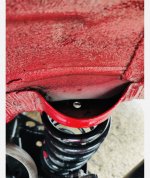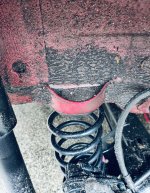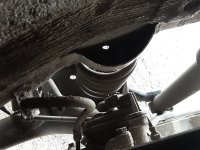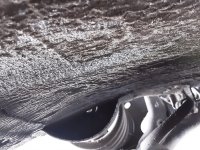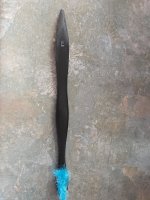You are using an out of date browser. It may not display this or other websites correctly.
You should upgrade or use an alternative browser.
You should upgrade or use an alternative browser.
Silver estate
Established Member
Perfectly normal as the wheel arches don’t have a liner like most so the near side if you’re driving on country lanes and tracks will get silt etc in whereas ooff side won’t as much as it’s in the centre of the roadDuring a change of tyres . I noticed this .. not something I’ve can me across in 40yrs of driving
I find that with the lift and drive axles on my work truck N/s is always dirtier the O/s under the arches
Jomarkh
Distinguished Member
- Joined
- Apr 5, 2021
- Messages
- 3,932
- Reaction score
- 2,477
- Points
- 1,049
- Location
- Southampton
- Driving
- MG5 Excite
Lovemyev
Distinguished Member
- Joined
- Jan 23, 2021
- Messages
- 8,136
- Reaction score
- 8,926
- Points
- 2,673
- Location
- N.Wales ZS EV ( Gen 2 ).
I totally agree, it is a very poor design, and a shite trap for sure ( as your pictures clearly displays.)This has been pointed out before - it's certainly poor design and something to keep clean.
The hole produced in the centre, is there to allow water to drain away.
However, it soon becomes blocked with road smut's / mud and dare I say it, road salt in the winter.
The dirt /mud etc act's like a giant sponge for water and never allows the area to completely dry out.
The water is not the problem, if the drain hole is kept free, there is not going to be a problem.
If it was my car, I would ensure that I cleaned out that area every couple of weeks, with a hose pipe or better still jet wash, if access is possible.
Better still, clean the area and at least improve factory rust protection ( with is extremely spartan ) with some additional protection, like stone chip etc etc.
There is many many products on the market for this type of thing.
You could go full belt and braces and then try and manufacture a shaped piece of strong plastic, made from a cardboard template, that could be bonded in place, using body seam sealer.
Even a thick piece of water proof foam, cu and shaped to fit into the cup and again, sealed into place with some body sealer.
Either of these would act as a roof over the area, totally eliminating any ingress of dirt and water into that area of the structure.
Access is not required for any type of mechanical work, so it could be a permanent fix.
The bottom hole, could be left open to provide a vent of air to circulate inside of the cup.
Should you need to go too these lengths ? - No of course not !.
It depends on how long you intend to keep the car and the level of preventative action you wish to take I guess ?.
See, that would constantly "Peck My Head" now, until I did something about it.
Hard to ignore now you have seen it ?
Lovemyev
Distinguished Member
- Joined
- Jan 23, 2021
- Messages
- 8,136
- Reaction score
- 8,926
- Points
- 2,673
- Location
- N.Wales ZS EV ( Gen 2 ).
Less to do with milage covered I think, but more to do with the road conditions the car is subjected too when driving !.
Country roads that generally contain more road smuts / mud are likely to cause the problem here I think to be totally honest.
It's less about the water content, more about the dirt contained IN that water, is the worrying factor here.
Clean ( ish ) water will pass quickly through the hole produced in the bottom of the rear spring retention cup, if it is subjected to a large amount of road smuts / muddy road conditions, the drain hole will become overwhelmed with crude, and drain hole WILL reduced in size, over time.
As a consequence of this, the drain hole then becomes redundant and its purpose it become ineffective.
The lodged wet smuts / mud, is therefore almost constantly wet and then promotes a perfect breading ground for metal corrosion.
This is totally typical on know areas of some car models, that do suffer from common areas of known metal corrosion.
It's a long long list, but the first one that instantly comes jumps to mind, is the old Ford KA.
Really massive body panel corrosion around the fuel filler neck area, on the rear quarter back panel of the car.
A very strange place you would expect to find extensive body corrosion, you would think ?.
As at first sight yes, as it appears to be WAY above what is considered to be the main water contact area for road water spray, you would think ?.
However, smuts leaving the rear tyre while driving, is constantly sprayed up on the inside of the rear wheel arch, its spray is then directly up towards the fuel tank filler neck pipe.
The fuel filler pipe is made from plastic and is no way affected, however the smuts / mud then lodges itself between the filler neck pipe and the rear quarter panel of the car.
Over time, this wet patch of smuts that has collected over time, is sitting hard against the metal rear body panel of the car.
As we all know in 99% of the time, corrosion starts from the backside of body panels.
It eventually eats its way through the metal and then, manifests itself as paint bubbles / blisters on the outside paint finish of the cars body work.
At this point, you are pretty much screwed !.
In many cases, these paint blisters will be removed and body filler applied.
The panel will be refinished and it looks great ( to sell on ) but six months latter, the problem is back, but is much worse this time !.
Keeping these vulnerable areas free from all road smuts, is absolutely key to success of reducing any chance of corrosion getting a hold on your car.
As somebody who has worked on cars in the 70's that have received little to NO form of anti corrosion prevention, then worked on the after math years latter, that have then required serious body panel replacements as cure, is not a fun place to be !.
Finding the back of body panels and major structural chassis parts stuffed with silver foil etc was typical back in the day.
Corrosion protection has come on leaps and bounds since then of course !.
But, I have always continued to hose / jet wash under my wheel arches of all of my cars, before washing the upper body.
Not ever single wash of course, but this is more important if you live in a rural / country environment, where the roads are particularly muddy / dirty.
Winter time is an extremely important time, as road salt is a death sentence to any untreated areas.
There are certain areas that are prone to the risk of body worm corrosion.
Anywhere that smuts / water is allowed to sit / collect on a long term basis.
Rear wheel arches where a VERY common place of for corrosion of course ( until protective plastic wheel arch liners where installed ) as wet road smuts, would get lodged in the wheel arch lip's and then it slowly eats away at the cars mild steel body construction.
Prevention is always better than ANY type of cure.
If you intend to exchange your car every three or four years ( via a PCP / Lease deal ) then none of this preventative action is of any relevance or importance of course.
As you are merely playing "Pass The Parcel" with your car.
For long term owners though, this maybe of some use / interest.
Remember, perforation rust always comes from the backside of any body panel.
Keeping the vulnerable areas clean of road smuts build up, is vitally important for the longer life of your car, a good controlled jet wash in the danger areas is your best friend.
Polishing paint work is always difficult to navigate around rust bubbles ?.
Country roads that generally contain more road smuts / mud are likely to cause the problem here I think to be totally honest.
It's less about the water content, more about the dirt contained IN that water, is the worrying factor here.
Clean ( ish ) water will pass quickly through the hole produced in the bottom of the rear spring retention cup, if it is subjected to a large amount of road smuts / muddy road conditions, the drain hole will become overwhelmed with crude, and drain hole WILL reduced in size, over time.
As a consequence of this, the drain hole then becomes redundant and its purpose it become ineffective.
The lodged wet smuts / mud, is therefore almost constantly wet and then promotes a perfect breading ground for metal corrosion.
This is totally typical on know areas of some car models, that do suffer from common areas of known metal corrosion.
It's a long long list, but the first one that instantly comes jumps to mind, is the old Ford KA.
Really massive body panel corrosion around the fuel filler neck area, on the rear quarter back panel of the car.
A very strange place you would expect to find extensive body corrosion, you would think ?.
As at first sight yes, as it appears to be WAY above what is considered to be the main water contact area for road water spray, you would think ?.
However, smuts leaving the rear tyre while driving, is constantly sprayed up on the inside of the rear wheel arch, its spray is then directly up towards the fuel tank filler neck pipe.
The fuel filler pipe is made from plastic and is no way affected, however the smuts / mud then lodges itself between the filler neck pipe and the rear quarter panel of the car.
Over time, this wet patch of smuts that has collected over time, is sitting hard against the metal rear body panel of the car.
As we all know in 99% of the time, corrosion starts from the backside of body panels.
It eventually eats its way through the metal and then, manifests itself as paint bubbles / blisters on the outside paint finish of the cars body work.
At this point, you are pretty much screwed !.
In many cases, these paint blisters will be removed and body filler applied.
The panel will be refinished and it looks great ( to sell on ) but six months latter, the problem is back, but is much worse this time !.
Keeping these vulnerable areas free from all road smuts, is absolutely key to success of reducing any chance of corrosion getting a hold on your car.
As somebody who has worked on cars in the 70's that have received little to NO form of anti corrosion prevention, then worked on the after math years latter, that have then required serious body panel replacements as cure, is not a fun place to be !.
Finding the back of body panels and major structural chassis parts stuffed with silver foil etc was typical back in the day.
Corrosion protection has come on leaps and bounds since then of course !.
But, I have always continued to hose / jet wash under my wheel arches of all of my cars, before washing the upper body.
Not ever single wash of course, but this is more important if you live in a rural / country environment, where the roads are particularly muddy / dirty.
Winter time is an extremely important time, as road salt is a death sentence to any untreated areas.
There are certain areas that are prone to the risk of body worm corrosion.
Anywhere that smuts / water is allowed to sit / collect on a long term basis.
Rear wheel arches where a VERY common place of for corrosion of course ( until protective plastic wheel arch liners where installed ) as wet road smuts, would get lodged in the wheel arch lip's and then it slowly eats away at the cars mild steel body construction.
Prevention is always better than ANY type of cure.
If you intend to exchange your car every three or four years ( via a PCP / Lease deal ) then none of this preventative action is of any relevance or importance of course.
As you are merely playing "Pass The Parcel" with your car.
For long term owners though, this maybe of some use / interest.
Remember, perforation rust always comes from the backside of any body panel.
Keeping the vulnerable areas clean of road smuts build up, is vitally important for the longer life of your car, a good controlled jet wash in the danger areas is your best friend.
Polishing paint work is always difficult to navigate around rust bubbles ?.
Jomarkh
Distinguished Member
- Joined
- Apr 5, 2021
- Messages
- 3,932
- Reaction score
- 2,477
- Points
- 1,049
- Location
- Southampton
- Driving
- MG5 Excite
Mine is on 18k so not that low?
BugEyed
Prominent Member
Hard to ignore now you have seen it ?.
Exactly. I'm in two minds whether to attempt to protect it or whether that will give MG room to wriggle out of the inevitable claims when they fail MoT tests in the future.
BrechMG5LR
Standard Member
802 word post might be taking this away from being a Forum to a short essay comparison site! All very valid but my what a read!!Less to do with milage covered I think, but more to do with the road conditions the car is subjected too when driving !.
Country roads that generally contain more road smuts / mud are likely to cause the problem here I think to be totally honest.
It's less about the water content, more about the dirt contained IN that water, is the worrying factor here.
Clean ( ish ) water will pass quickly through the hole produced in the bottom of the rear spring retention cup, if it is subjected to a large amount of road smuts / muddy road conditions, the drain hole will become overwhelmed with crude, and drain hole WILL reduced in size, over time.
As a consequence of this, the drain hole then becomes redundant and its purpose it become ineffective.
The lodged wet smuts / mud, is therefore almost constantly wet and then promotes a perfect breading ground for metal corrosion.
This is totally typical on know areas of some car models, that do suffer from common areas of known metal corrosion.
It's a long long list, but the first one that instantly comes jumps to mind, is the old Ford KA.
Really massive body panel corrosion around the fuel filler neck area, on the rear quarter back panel of the car.
A very strange place you would expect to find extensive body corrosion, you would think ?.
As at first sight yes, as it appears to be WAY above what is considered to be the main water contact area for road water spray, you would think ?.
However, smuts leaving the rear tyre while driving, is constantly sprayed up on the inside of the rear wheel arch, its spray is then directly up towards the fuel tank filler neck pipe.
The fuel filler pipe is made from plastic and is no way affected, however the smuts / mud then lodges itself between the filler neck pipe and the rear quarter panel of the car.
Over time, this wet patch of smuts that has collected over time, is sitting hard against the metal rear body panel of the car.
As we all know in 99% of the time, corrosion starts from the backside of body panels.
It eventually eats its way through the metal and then, manifests itself as paint bubbles / blisters on the outside paint finish of the cars body work.
At this point, you are pretty much screwed !.
In many cases, these paint blisters will be removed and body filler applied.
The panel will be refinished and it looks great ( to sell on ) but six months latter, the problem is back, but is much worse this time !.
Keeping these vulnerable areas free from all road smuts, is absolutely key to success of reducing any chance of corrosion getting a hold on your car.
As somebody who has worked on cars in the 70's that have received little to NO form of anti corrosion prevention, then worked on the after math years latter, that have then required serious body panel replacements as cure, is not a fun place to be !.
Finding the back of body panels and major structural chassis parts stuffed with silver foil etc was typical back in the day.
Corrosion protection has come on leaps and bounds since then of course !.
But, I have always continued to hose / jet wash under my wheel arches of all of my cars, before washing the upper body.
Not ever single wash of course, but this is more important if you live in a rural / country environment, where the roads are particularly muddy / dirty.
Winter time is an extremely important time, as road salt is a death sentence to any untreated areas.
There are certain areas that are prone to the risk of body worm corrosion.
Anywhere that smuts / water is allowed to sit / collect on a long term basis.
Rear wheel arches where a VERY common place of for corrosion of course ( until protective plastic wheel arch liners where installed ) as wet road smuts, would get lodged in the wheel arch lip's and then it slowly eats away at the cars mild steel body construction.
Prevention is always better than ANY type of cure.
If you intend to exchange your car every three or four years ( via a PCP / Lease deal ) then none of this preventative action is of any relevance or importance of course.
As you are merely playing "Pass The Parcel" with your car.
For long term owners though, this maybe of some use / interest.
Remember, perforation rust always comes from the backside of any body panel.
Keeping the vulnerable areas clean of road smuts build up, is vitally important for the longer life of your car, a good controlled jet wash in the danger areas is your best friend.
Polishing paint work is always difficult to navigate around rust bubbles ?.
Lovemyev
Distinguished Member
- Joined
- Jan 23, 2021
- Messages
- 8,136
- Reaction score
- 8,926
- Points
- 2,673
- Location
- N.Wales ZS EV ( Gen 2 ).
Better to avoid the problem in the first place, would be my best advice.Exactly. I'm in two minds whether to attempt to protect it or whether that will give MG room to wriggle out of the inevitable claims when they fail MoT tests in the future.
If it was my car and I intended to keep it long term, then I would do it without an second thoughts to be honest.
Prevention is better than cure in my book, every single time !.
If you did nothing to improve the situation, do I think it would be a problem within the warranty period ?.
Honestly - NO.
But if it was picked up at around 8 years, which is now outside of the warranty, then the car would require some extensive and very expensive work to rectify the problem.
Rear axle to be removed and interior ripped out to avoid any chance of a fire, even remove the HV pack etc.
At this point ( given the age of the HV battery ) the car would likely be scrapped !.
Yeah - Like I said above, it really depends strongly on if you intend to keep the car.
It “Pecks Your Head” only because it can be simply prevented, the question is, do you want to do anything about it I guess ?.
Me - Yes.
Others - No very unlikely I would suggest.
Like the question :- “Should I improve the original ( skippy ) factory under body protection, by applying some internal cavity
Injection wax oil”.
Ask the owner in ten years if he did the right thing or not, is the correct answer.
Question :- Who does keep a car more than ten years these days ?.
No many I think.
As a OAP - I am unlikely to be driving an car in tens years time, never mind a rust bucket !.
God knows, I have driven plenty of them in my time.
The type that you can see the tarmac passing by as you drive ?.
Lovemyev
Distinguished Member
- Joined
- Jan 23, 2021
- Messages
- 8,136
- Reaction score
- 8,926
- Points
- 2,673
- Location
- N.Wales ZS EV ( Gen 2 ).
You can never have to much information I say ?.802 word post might be taking this away from being a Forum to a short essay comparison site! All very valid but my what a read!!
Preparation is the key to success !.
Fail to plan, plan to fail is my motto.
Cheers !.
Jomarkh
Distinguished Member
- Joined
- Apr 5, 2021
- Messages
- 3,932
- Reaction score
- 2,477
- Points
- 1,049
- Location
- Southampton
- Driving
- MG5 Excite
smokie
Prominent Member
It's a toothbrush.
What's my prize?
What's my prize?
Dean0114
Standard Member
Thanks for replyLess to do with milage covered I think, but more to do with the road conditions the car is subjected too when driving !.
Country roads that generally contain more road smuts / mud are likely to cause the problem here I think to be totally honest.
It's less about the water content, more about the dirt contained IN that water, is the worrying factor here.
Clean ( ish ) water will pass quickly through the hole produced in the bottom of the rear spring retention cup, if it is subjected to a large amount of road smuts / muddy road conditions, the drain hole will become overwhelmed with crude, and drain hole WILL reduced in size, over time.
As a consequence of this, the drain hole then becomes redundant and its purpose it become ineffective.
The lodged wet smuts / mud, is therefore almost constantly wet and then promotes a perfect breading ground for metal corrosion.
This is totally typical on know areas of some car models, that do suffer from common areas of known metal corrosion.
It's a long long list, but the first one that instantly comes jumps to mind, is the old Ford KA.
Really massive body panel corrosion around the fuel filler neck area, on the rear quarter back panel of the car.
A very strange place you would expect to find extensive body corrosion, you would think ?.
As at first sight yes, as it appears to be WAY above what is considered to be the main water contact area for road water spray, you would think ?.
However, smuts leaving the rear tyre while driving, is constantly sprayed up on the inside of the rear wheel arch, its spray is then directly up towards the fuel tank filler neck pipe.
The fuel filler pipe is made from plastic and is no way affected, however the smuts / mud then lodges itself between the filler neck pipe and the rear quarter panel of the car.
Over time, this wet patch of smuts that has collected over time, is sitting hard against the metal rear body panel of the car.
As we all know in 99% of the time, corrosion starts from the backside of body panels.
It eventually eats its way through the metal and then, manifests itself as paint bubbles / blisters on the outside paint finish of the cars body work.
At this point, you are pretty much screwed !.
In many cases, these paint blisters will be removed and body filler applied.
The panel will be refinished and it looks great ( to sell on ) but six months latter, the problem is back, but is much worse this time !.
Keeping these vulnerable areas free from all road smuts, is absolutely key to success of reducing any chance of corrosion getting a hold on your car.
As somebody who has worked on cars in the 70's that have received little to NO form of anti corrosion prevention, then worked on the after math years latter, that have then required serious body panel replacements as cure, is not a fun place to be !.
Finding the back of body panels and major structural chassis parts stuffed with silver foil etc was typical back in the day.
Corrosion protection has come on leaps and bounds since then of course !.
But, I have always continued to hose / jet wash under my wheel arches of all of my cars, before washing the upper body.
Not ever single wash of course, but this is more important if you live in a rural / country environment, where the roads are particularly muddy / dirty.
Winter time is an extremely important time, as road salt is a death sentence to any untreated areas.
There are certain areas that are prone to the risk of body worm corrosion.
Anywhere that smuts / water is allowed to sit / collect on a long term basis.
Rear wheel arches where a VERY common place of for corrosion of course ( until protective plastic wheel arch liners where installed ) as wet road smuts, would get lodged in the wheel arch lip's and then it slowly eats away at the cars mild steel body construction.
Prevention is always better than ANY type of cure.
If you intend to exchange your car every three or four years ( via a PCP / Lease deal ) then none of this preventative action is of any relevance or importance of course.
As you are merely playing "Pass The Parcel" with your car.
For long term owners though, this maybe of some use / interest.
Remember, perforation rust always comes from the backside of any body panel.
Keeping the vulnerable areas clean of road smuts build up, is vitally important for the longer life of your car, a good controlled jet wash in the danger areas is your best friend.
Polishing paint work is always difficult to navigate around rust bubbles ?.
As in aware of this issue it will be cleaned regular now
Even tho I'm a high miler I tend to do this on major city and do expect in keeping car till it's death probably ten yrs
Saw I may consider having it capped off in the near future
Jomarkh
Distinguished Member
- Joined
- Apr 5, 2021
- Messages
- 3,932
- Reaction score
- 2,477
- Points
- 1,049
- Location
- Southampton
- Driving
- MG5 Excite
I did shape the end to fit the hole?It's a toothbrush.
What's my prize?
Lguk
Established Member
I assumed it was to shiv the dealer ?I did shape the end to fit the hole?
Similar threads
- Replies
- 4
- Views
- 347
